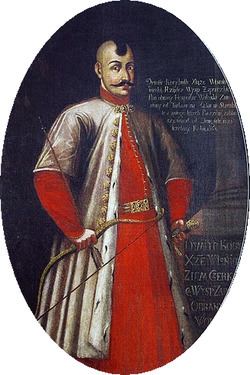Religion Eastern Orthodox Parents Ivan Vishnevetskiy Signature | Name Dmytro Vyshnevetsky Nephews Konstanty Wisniowiecki | |
 | ||
Siblings Konstantin Vishnevetskiy, Mikhail Vishnevetskiy, Andrey Vishnevetskiy, Yekaterina Vishnevetskaya Nieces Sapega Anna, Radzivill Elizaveta | ||
Grandparents Myhaylo Vyshnevetsky | ||
Dmytro Ivanovych Vyshnevetsky (Ukrainian: Дмитро Іванович Вишневе́цький; Russian: Дмитрий Иванович Вишневе́цкий; Polish: Dymitr Wiśniowiecki) was a Hetman of the Ukrainian Cossacks. He was also known as Baida in the Ukrainian folk songs.
Contents
Biography
Dmytro Vyshnevetsky was born into the powerful family of Ruthenian magnate Ivan Wiśniowiecki (?-1542) (part of Gediminids bloodline and the youngest son of Michal Zbaraski) and Anastasia Semenivna Olizarovychevna (?-1536). The Wiśniowiecki family takes its roots from the princely family of Novhorod-Siverskyi, through Dmitriy Korybut (see Kaributas) and Anastasia of Ryazan.
At first Dmytro Vyshnevetsky lived in the town of Vyshnivets of the Kremenets Powiat (county). In 1550–1553, Vyshnevetsky became a starosta of the Cherkasy and the Kaniv Powiats. He was the first true Cossack Hetman in history.
Dmytro Baida Vyshnevetsky was an able leader, although somewhat of a reckless adventurer. He started organizing a Cossack army in 1550 against the Crimean Khanate. Displeased with the king Sigismund II Augustus's policy of Catholization and centralization of power, he was ready to go over to the Turks. However, he was appointed to fortify the island of Mala Khortytsia on the Dnipro beyond the rapids. According to Hrushevsky, Vyshnevetsky built the fortress out of his own pocket as both Sigismund II Augustus and Devlet I Giray refused to provide any assistance. Eventually he managed to develop it to the point that khan Devlet I Giray could not take it, and he deflected the khan's efforts to Moskovia.
In 1556 in service to Ivan the Terrible he helped lead two raids of Ukrainian Cossacks and Russians against the Crimean Tatars around Ochakiv. In 1558 he raided around Perekop. In 1559 he raided down the Donets and Don. With the start of the Livonian War, Ivan turned his attention west and Vyshnevetsky, being Ivan's close relative and his governor in the North Caucasus, returned to the Lithuanian service with a great number of his Adyghe warriors. His Pyatigorsky detachments became the major military force of the Polish-Lithuanian Commonwealth in centuries to come. In 1561, at the request of the Lithuanian prince, he went back to fortifying Khortytsia.
In 1563 he was involved in Moldavian affairs, perhaps hoping to obtain the throne of Moldavia, but was defeated by the Turks, taken prisoner, and after the refusal of Ivan the Terrible to free his relative, he was tortured to death in Constantinople.
Vyshnevetsky's fortifications on Khortytsia, called sich, served as a prototype for later fortifications of the Zaporizhian Sich.
In popular culture
Probably not having any relationship to the situation, Vyshnevetsky's portrait is clearly featured in the epic-movie The Deluge by Jerzy Hoffman.
He also appears as an antagonist in The Ringed Castle, a 1971 novel by Dorothy Dunnett.
In the film Propala Hramota (The lost letter, 1972), a fragment of the above-mentioned old Ukrainian folk song was sung by Ivan Mykolaychuk:
